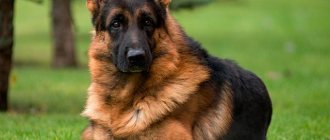How long beagles live - hound dogs with a keen sense of smell - is influenced primarily by the characteristics of the breed, its corresponding characteristics and, of course, the conditions in which the pet is kept.
The name of the breed speaks for itself, beagle, translated from French - gorloder indicates the dog’s ability to emit a long and loud bark and notify the owner about the hunted game. The lifespan of these dogs of English origin varies between 10-15 years, for a small hunting dog this is a long time.
Interesting! Beagles, avid hunters of rabbits and hares, are popular with customs services due to their sense of smell and easily cope with their duties, for example, in terms of detecting explosives.
Factors influencing a dog's life
Beagles are pets, so they are kept in apartments or private homes. Due to their small size and lack of undercoat, dogs cannot be tucked into sleds or kept in outdoor enclosures.
The dog should be walked at least 2 times a day. Moderate physical activity is important to them. The duration of the morning walk is about an hour. Beagles do not pose a danger to others, so you can walk with them without a muzzle and with a long leash.
It is important to feed your dog properly. Food should be rich in proteins, carbohydrates, vitamins and beneficial microelements.
These include:
- Lean meat and boneless fish;
- Canned meat and fish;
- Dietary soups and cereals;
- Boiled eggs;
- Boiled potatoes;
- Dairy products;
- Vegetable stew;
- Fruits;
- Dog food.
Adult beagles eat in the morning and late afternoon. Puppies of the breed must eat at least 4 times, depending on their age. Adult dogs can weigh up to 15 kg.
Beagles often suffer from acquired and hereditary diseases.
This breed is susceptible to:
- Heart diseases, which are manifested by disturbances in the functioning of the valve apparatus, coronary heart disease and coronary circulatory disorders.
- Oncological neoplasms. As dogs age, atypia of cellular structures occurs, which over time leads to the development of formations of benign or malignant etiology.
- Pathologies of the musculoskeletal system. Joint dysplasia is a common disease in dogs with short legs.
- Diseases of the endocrine glands. Beagles are often susceptible to diseases of the pancreas, thyroid gland, and adrenal cortex.
Dogs are bathed several times a month. The coat should be brushed 3-4 times a week with rubber gloves or a brush. To prevent diseases, it is worth examining your pet for defects or pathologies and monitoring its health.
Beagles are trained in canine centers where they are provided with the necessary conditions. They can be taught basic commands at home.
Dogs of this breed are excellent human friends. They quickly adapt to people and do not experience aggression towards other animals. The pet requires constant care. If all rules of keeping in a home environment are followed, a beagle can live more than 15 years.
Training and education
Independence bordering on stubbornness is a character trait of a born bloodhound and hound. A dog that is too dependent on a person's decisions and unable to take initiative cannot be a good hunter.
However, there is also some difficulty in raising a pet:
- Beagles are highly trainable dogs, but they do not tolerate suppression of their own desires. It will not be possible to “crush” such a pet with authority, and instead of obedience, the dog will show stubbornness. Breeders recommend starting Beagle training from early puppyhood through play.
- It is very important to build relationships correctly, where the person is in charge, the leader. However, the owner must prove his superiority very tactfully and with love for the dog. Strictly suppress disobedience, but do not suppress the will of the dog. Beginner dog owners are advised to enroll in training courses or use the help of a professional dog handler.
Proof that beagles are very smart and trainable dogs will be a video from the channel “Animal Art Agency - Animals for Filming.”
Causes of premature death of a dog
Accidents, poisoning, and existing pathologies of internal organs lead to the sudden death of animals. Negative consequences are difficult to predict, however, it is preferable to know what potential dangers threaten your pet.
Common causes of premature canine death:
- poisoning;
- heart disease;
- pneumothorax;
- tracheal collapse;
- congenital abnormalities;
- expansion, volvulus of the stomach;
- ulcer;
- splenic tumor rupture;
- foreign body entering the throat;
- heatstroke;
- injury.
Dogs often suffer from poisons intended for rodents, poisons distributed to exterminate stray dogs. During a walk, be sure to keep an eye on your pet; if the dog does not respond to the command “ugh,” put on a closed muzzle so that the dog does not try questionable “food.”
Heart diseases can manifest asymptomatically, but if a young dog gets tired quickly, is weak, or is breathing heavily, you need to visit a veterinarian for a diagnostic examination.
Air accumulation in the peripulmonary space (pneumothorax) occurs due to injuries to the sternum leading to damage to the emphysematous bladder or existing tumor on the lung.
Tracheal collapse is more common in small breeds, is expressed by a sharp cough after active mobility or the manifestation of strong emotions, and sometimes occurs as a complication of past infections.
A congenital pathology that leads to tragic consequences is the displacement of the cervical vertebrae as a result of insufficient development or defect of the ligaments. An accidental jolt to the problem area can cause pressure on the spinal cord and be fatal.
Gastric dilatation and volvulus are more common in older dogs; both pathologies interfere with the normal blood supply to other organs and are considered deadly. Prevention of stomach problems is considered to be proper nutrition, adherence to a feeding regime and moderate exercise.
The premature death of the animal is caused by complications of peptic ulcer disease, expressed in the formation of a through hole in the wall of the stomach or bleeding. A precaution is the proper nutrition of your pet.
New growths on the spleen (benign and malignant) are susceptible to rupture, which can lead to fatal loss of blood. Tumor rupture is possible even with minor damage caused by difficult bowel movements or increased physical activity.
Swallowing a foreign object risks suffocation or injury to internal organs as the swallowed object moves inside.
Heatstroke is caused by severe overheating of the body and often occurs in dogs locked in a car in hot weather.
A dog can be injured on the street (being hit by a car, fighting with other dogs, etc.), at home (falling from a height, electric shock, etc.), the danger of injury depends on the degree of its severity and the provision of first aid.
Interesting Facts
There are many interesting facts and legends about this breed. Beagles were very loved by the English monarchs. For example, Elizabeth I had almost two dozen dogs, so the barking of dogs practically did not subside in the palace, but this did not bother her.
Other crowned persons also had representatives of this breed, including Henry VIII and Edward II. Charles Darwin did not remain indifferent to dogs; he took his beagle on expeditions. And later he named the ship after him, namely “His Majesty’s Ship Beagle.”
Beagles have a cheerful and good-natured character. But the owner should not forget about their hunting past, so on the street it is important to ensure that the pet does not chase someone’s cat or get hit by a car while trying to catch a pigeon.
Caring for an older dog
At home, an elderly pet should be provided with:
- balanced food, following the feeding regimen;
- monitoring the animal’s body weight and well-being;
- maintaining hygiene (grooming, cleaning the mouth, eyes, ears, trimming nails);
- prevention against parasites;
- moderate physical activity.
Regular preventive examinations of the dog at the veterinarian will help identify diseases and age-related changes in the body, promptly take appropriate measures to treat emerging diseases and alleviate the pet’s condition.
Video “Beagle is a unique breed”
Beagles can produce several types of bark: regular, howling while picking up a scent, and hoarse howl. These dogs can also find domestic parasites: truly unique pets. A video from the “101 Breeds” program series is dedicated to a dog who was looking for bedbugs.
Was this article helpful?
Thank you for your opinion!
The article was useful. Please share the information with your friends.
Yes
No
X
Please write what is wrong and leave recommendations on the article
Cancel reply
Rate the benefit of the article: Rate the author ( 3 votes, average: 3.67 out of 5)
Discuss the article:
Factors influencing lifespan
The life expectancy of dogs is influenced by factors:
- Physical development;
- Does the animal perform loads appropriate for its age and breed;
- Complete rest;
- A balanced diet enriched with nutrients;
- Sufficient communication and attention.
All these quality indicators of life depend 100% on the owner. The way he takes care of his pet shapes the animal’s resistance to stress and various diseases.
A balanced diet from birth lays the foundation for the pet’s physical health for the rest of its life and even into old age. An older dog should be fed soft food to avoid problems with teeth and swallowing.
In old age, animals can suffer from various diseases, most often deteriorating hearing, vision, and disruptions in the urinary system.
Another problem that can significantly reduce the age of any animal is excess weight. Its excess has a bad effect on the pet’s health, affecting the cardiovascular system and bone structure. It is necessary to control the weight of the animal, especially in old age.
Regular medical examinations, vaccinations, timely contacting a veterinary clinic in case of problems - this is what will keep your pet in the right shape. Constantly caring for your pet throughout its life can significantly increase its cycle.
Choosing a puppy
When planning to choose a hound puppy, it is very important to know the purpose of purchasing such a pet. Before purchasing, be sure to study special literature about the breed and find out its characteristics.
Basic criteria for assessing a puppy:
- body type;
- posture of limbs;
- color;
- wool quality;
- bite;
- behavior.
The best age for a puppy to move to a new home is 2.5-3 months.
Three month old beagle puppies
Where to buy and how much does it cost?
It is recommended to purchase Beagle puppies from specialized nurseries.
The cost of a puppy is determined by a number of criteria and is:
- average price – 20,000 rubles;
- a dog without a pedigree and without prospects for participation in exhibitions or shows can be bought for 10,000-15,000 rubles;
- Show-class beagles will cost at least 30,000 rubles.
The maximum price depends on the prestige of the club, the fame of the breeder or the value of the sires.
What to look for when choosing?
If you buy a dog from a kennel, it must have:
- brand;
- puppy card with the entered data of the parents and kennel;
- veterinary passport: notes on vaccinations, treatments against parasites.
In this case, the puppy should not be lethargic or inactive. The little beagle has well-developed muscles and limbs, so weakness or, for example, lameness should alert the future owner.
How long do purebred animals live?
According to veterinary experts, there is a clear relationship between the breed and the years measured to the animal. It has been scientifically proven that the smaller the dog, the longer its life.
The vitality of representatives of different breeds varies. This is due to human breeding activities. When developing standards, dogs develop and reinforce features that are often unnatural.
Breeding a breed is fraught with complications, which are expressed in hereditary diseases:
- Chihuahua. These cute little creatures are genetically prone to medial dislocations of the kneecaps, elbow joints, and various dysplasias.
- Dachshund. Natural hunters, with a funny long body on short legs, pay with health for such a body structure. Hereditary pathology in dachshunds is intervertebral disc disease.
- Shar-Pei. Not only in this breed of dog, but in all pets with skin folds, the disease entropion, which is essentially an entropion of the eyelid, is common.
- Rottweilers. Strong, brave, fearless, smart. But they are also susceptible to hereditary diseases - aortic stenosis, Rottweiler leukoencephalopathy, follicular lipidosis.
- Pikines. This ancient breed is distinguished by a special eye structure, for which it suffers from a tendency to eversion of the eyelids, cataracts, and corneal ulcers.
Each breed has its own Achilles heel - dogs with flat faces have problems with the respiratory system, with skin without fur - they suffer from allergies, large pets are often diagnosed with diseases of the joints and bones.
Breeders allow for different situations that affect the life expectancy of dogs:
- Inbreeding;
- Exclusion of the factor of natural selection;
- The appearance of the offspring becomes a priority, not health;
- The lifespan of the progenitors of the offspring is not taken into account.
Dogs of breeds that are less susceptible to selection changes, of medium size, without any special appearance, live the longest. These are terriers, shepherds, huskies.
The presence of long-livers in the family is of great importance. If the pet's parents lived to a ripe old age, then it has every chance of a long life. If we talk about numbers, on average, dogs live about 12 years.
Description and characteristics of the breed
The Beagle breed was bred for rutting small animals for hunting on foot and in terms of working qualities is not inferior to its taller counterparts. Centuries-old selection has made it possible to obtain an almost universal companion breed, thanks to which the dogs are popular to this day. The main feature of beagles, unlike other hunting breeds, is their external charm and characteristic “languid look” (as in the photo).
Typical Beagle Look
Beagles gained enormous popularity in the world after the release of a comic book with the funny dog Snoopy in 1950. It was invented by the American artist Charles Monroe Schultz, who copied the habits and character of his four-legged friend from his youth.
Story
Very little is known about the origins of beagles. This is an ancient breed that boasts a 700-year history. They say that such dogs accompanied the Knights of the Round Table. There is a version that the ancestors of modern beagles were described by Xenophon back in the 4th century BC. e.
England is considered the birthplace of the breed, where small hounds lived in the royal court for many centuries. However, the French claim that the breed is of French origin from dogs brought to Foggy Albion in the 6th century. Beagles reached their peak during the time of Elizabeth the First, but at that time the breed was not yet fully formed. At the end of the 18th century, beagle breeders began to unite and breed dogs for sporting and exhibition purposes.
Main breed dates:
- in 1890 the first English Beagle Club was founded;
- In 1895, a breed standard was written and approved.
- in 1896, beagles were officially presented at an exhibition in Birmingham (their appearance has remained virtually unchanged since that time).
The dog got its name “beagle” because of its small size. Translated from Old English "begle" and Old French "beigh" means "small". It is known that until the 17th century all representatives of small hounds were called this way.
Breed standard
According to the standard description, the Beagle is a strong, but compact, medium-sized dog with a muscular, athletic body. An ideal characteristic does not allow the presence of rough features and lines. The height at the withers of an adult dog is 33-40 cm, weight – 8-13 kg.
The breed standard has been adjusted several times, but modern breeders use the 1998 version.
| Body | The body is rectangular, the bones are strong, the body is muscular without being too lean. |
| Head | Powerful, but not rough, elongated, without folds or wrinkles. The skull is convex, moderately wide with a small ridge at the back of the head. A well-defined stop divides the head into equal parts. The muzzle is wide, the lips are downturned. The eyes are large and widely spaced. |
| Neck | Well developed, muscular, allowing the dog to lower its nose low to the ground. Males are more powerful than females. |
| Breast | Deep, rounded with a slight dewlap. |
| Back | Straight, loin short and strong. |
| Limbs | Straight, muscular, strong. The wrist is short, the paws are dense. Hare feet are considered a defect. |
| Tail | Strong, tall, of moderate length, crescent-shaped over the back, but not carried over the back. When moving during the rut it stands up. |
| Ears | Long and thin, rounded at the ends, low, tightly pressed to the cheekbones. They reach to the tip of the nose, but no more. |
Coat and colors
Beagles have short, smooth, soft fur. The guard hair fits tightly to the skin, without hiding the lines of the body. Despite its short length, the thick undercoat protects the dog well from bad weather.
Features of the color of the breed:
- two- or three-color color in a combination of white and black with any shades of brown;
- white without spots is allowed;
- a white, preferably symmetrical mask on the head;
- Be sure to have a white tip of the tail.
The request returned an empty result.
Varieties
In the 16th century, in addition to the standard Beagle, there was a mini version - the Pocket Beagle. The height of such adult bloodhounds did not exceed 25 cm. This species was not intended for hunting and was popular as a pocket dog among court ladies.
Today, there are two types of dogs within the breed:
- European beagle;
- American Beagle (slightly larger than the European type).
The request returned an empty result.
How long do beagles live?
The average lifespan of dogs is 12-14 years. With proper care, some individuals live up to 15-17 years.
Owner reviews
As a child, I watched the movie “Cats vs. Dogs” and simply fell in love with the Beagle breed. However, my parents did not allow me to have a dog, since there was already a cat in the house. Having moved to my own home, I immediately bought a beagle puppy. He was charming. But it wasn't without problems. At one time he constantly attacked my legs and bit me until I bruised. I don’t know what caused such aggression. But over time it passed.
Barnik taught me not to leave my things on the floor. All found “treasures” immediately turned into trash. This gave me a lot of discipline. Advice to everyone who wants to become beagle owners - think and read 100 times about the breed and walk your pet as often as possible. Then he will have no energy left to damage property.
We got our beagle almost by accident. We were preparing for the arrival of a hunting dog in the family, but we thought that we would take a puppy, but one day we saw an advertisement for the sale of an adult dog. The previous owners abandoned Chuck because... The kid has allergies, but I think they just couldn't handle Chuck. He had health problems - obesity, but this went away because we walked him a lot and fed him high-quality food. This dog is incredibly friendly and energetic. In general, beagles do a lot of mischief in the house, but our only damage was to the front door. When we go to work, we barricade it as best we can. Our Chuck always accompanies us, looking out the window. And he also greets me from work. On the street I keep him on a leash, as this sniffer can get carried away and go very far.











